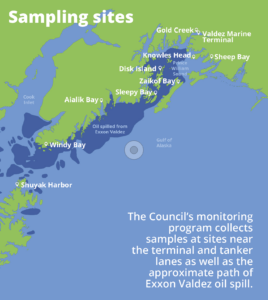 Thirty years ago, a new Council program was just getting underway. The assignment for the new Long-Term Environmental Monitoring Program was to identify adverse impacts of the oil industry on the ecosystems in Prince William Sound and the Gulf of Alaska.
Thirty years ago, a new Council program was just getting underway. The assignment for the new Long-Term Environmental Monitoring Program was to identify adverse impacts of the oil industry on the ecosystems in Prince William Sound and the Gulf of Alaska.
Just a few years prior, as a result of the devastating Exxon Valdez oil spill, the U.S. Congress had passed a law requiring such a monitoring program.
The Council worked with researchers to develop the program’s plan that, with some modifications to incorporate new technologies, is still in existence today.
Copying the approach taken by NOAA to monitor other areas, the program developers included two main tasks. Those were to combine chemical and biological assessment tools to determine whether hydrocarbons from the nearby oil industry:
- Accumulated in nearby sediments
- Affected nearby aquatic organisms
Starting in 1993, researchers began collecting samples of the sediments and blue mussels. Ten locations were chosen throughout Prince William Sound and the Gulf of Alaska, largely following the path of the Exxon Valdez oil spill.
The monitoring in Port Valdez is mostly focused on assessing the environmental impacts of the Valdez Marine Terminal while the monitoring elsewhere is focused on assessing the impacts of oil tankers, including possible lingering oil from the Exxon Valdez spill. In addition to sites that were heavily oiled in 1989, the monitoring is also done at clean, unoiled sites for comparison.
Mussels were chosen because they filter large amounts of water and they remain in one location. They have been shown to accumulate hydrocarbons when they are nearby, and to eliminate the hydrocarbons during cleaner conditions. This means mussels reflect what is happening in their environment better than other organisms.
The program today
Three types of samples are analyzed today. Mussels and sediments are collected as in years past, and in 2016, researchers added a new tool called a passive sampling device. These are special plastic strips deployed underwater to which oil particles adhere. They can detect lower levels of hydrocarbons than the mussel and sediment sampling.
All three sample types are sent out to laboratories for chemical analysis. The labs measure and report the various types of oil contamination. Then scientists interpret the data.
Effects on genes: In 2019, the Council began looking into new methods to measure the impacts of oil on organisms in the environment. Researchers conducted a pilot study, analyzing genes of mussels using a technique known as “transcriptomics.”
Transcriptomics involves measuring how particular genes are expressed in an organism. This expression can be affected by conditions in the environment, such as exposure to hydrocarbons.

Read more about this work: Long-Term Environmental Monitoring